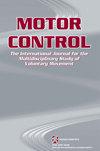Range of Motion Remains Constant as Movement Rate Decreases During a Repetitive High-Speed Knee Flexion-Extension Task.
IF 0.9
4区 医学
Q4 NEUROSCIENCES
引用次数: 0
Abstract
Maintaining the range of motion in repetitive movement tasks is a crucial point since it directly influences the movement rate. Ensuring the movement amplitude can be reliably maintained when motor function is assessed by measuring the maximum movement rate is therefore a key consideration. However, the performed range of motion during such tasks is often not reported. This study aimed to determine whether individuals are able to maintain an intended range of motion during a knee flexion/extension maximum movement rate task in the absence of tactile and visual feedback. Twelve healthy male individuals performed knee flexion/extension at maximum speed for eight 10-s blocks in a 45° arc between 45° and 90°. The range of motion was monitored using a marker system and the movement rate was measured. The performed range of motion was not significantly different from the 45° arc during the task despite a 13.47% decrease in movement rate from the start to the end of the task. Nevertheless, there was only anecdotal evidence of no difference from 45° in most blocks, while on the second and seventh blocks, there was anecdotal evidence of differences in the Bayesian one-sample test. There was also no significant shift in the maximum flexion/extension angles throughout the task. Healthy male individuals were thus able to perform a consistent average predefined knee range of motion in a maximum movement rate task despite decreases in movement rate. This was achieved without constraint-inducing devices during the task, using only basic equipment and verbal feedback.在重复的高速膝关节屈伸任务中,当运动速率降低时,运动范围保持不变。
在重复运动任务中保持运动范围是一个关键点,因为它直接影响运动速率。因此,当通过测量最大运动速率来评估运动功能时,确保运动幅度能够可靠地保持是一个关键考虑因素。然而,在这样的任务期间执行的运动范围通常不被报告。本研究旨在确定在没有触觉和视觉反馈的情况下,个体是否能够在膝关节屈曲/伸展最大运动速率任务中保持预期的运动范围。12名健康男性在45°至90°之间的45°弧线上以最大速度进行了8次10秒的膝关节屈曲/伸展。使用标记系统监测运动范围,并测量运动速率。尽管从任务开始到结束,运动速度下降了13.47%,但在任务期间,执行的运动范围与45°弧线没有显著差异。然而,在大多数区块中,只有传闻证据表明45°没有差异,而在第二个和第七个区块中,有传闻证据表明贝叶斯单样本测试存在差异。在整个任务中,最大屈伸角度也没有显著变化。因此,健康男性个体能够在最大运动速率任务中执行一致的平均预定义膝盖运动范围,尽管运动速率降低。这是在任务期间在没有约束诱导装置的情况下实现的,只使用了基本设备和口头反馈。
本文章由计算机程序翻译,如有差异,请以英文原文为准。
求助全文
约1分钟内获得全文
求助全文
来源期刊

Motor Control
医学-神经科学
CiteScore
1.80
自引率
9.10%
发文量
48
审稿时长
>12 weeks
期刊介绍:
Motor Control (MC), a peer-reviewed journal, provides a multidisciplinary examination of human movement across the lifespan. To keep you abreast of current developments in the field of motor control, it offers timely coverage of important topics, including issues related to motor disorders. This international journal publishes many types of research papers, from clinical experimental to modeling and theoretical studies. These papers come from such varied disciplines as biomechanics, kinesiology, neurophysiology, neuroscience, psychology, physical medicine, and rehabilitation.
Motor Control, the official journal of the International Society of Motor Control, is designed to provide a multidisciplinary forum for the exchange of scientific information on the control of human movement across the lifespan, including issues related to motor disorders.
Motor Control encourages submission of papers from a variety of disciplines including, but not limited to, biomechanics, kinesiology, neurophysiology, neuroscience, psychology, physical medicine, and rehabilitation. This peer-reviewed journal publishes a wide variety of types of research papers including clinical experimental, modeling, and theoretical studies. To be considered for publication, papers should clearly demonstrate a contribution to the understanding of control of movement.
In addition to publishing research papers, Motor Control publishes review articles, quick communications, commentaries, target articles, and book reviews. When warranted, an entire issue may be devoted to a specific topic within the area of motor control.
 求助内容:
求助内容: 应助结果提醒方式:
应助结果提醒方式:


